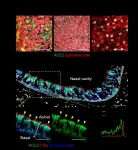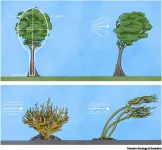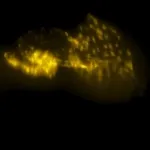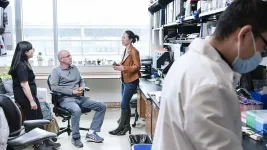SARS-CoV-2 replication targets nasal ciliated cells early in COVID-19 infection
The establishment of nasal mucosal immunity against SARS-CoV-2 through a nasal vaccine could be the most efficient way to combat COVID-19 infection
2021-07-01
(Press-News.org) Understanding how viral infection occurs can provide important clues for researchers to develop strategies to prevent viral transmission and develop effective therapeutic agents and vaccines. SARS-CoV-2, the causative agent of COVID-19, enters the host cells through interaction between the virus's spike protein and the extracellular receptor binding domain of ACE2. The viral entry into the cells is completed by various proteases, which allow the viral and cell membranes to fuse together. While it is known that the upper respiratory tract becomes compromised in the early infection, the exact types of the cells that the virus infects at the earliest stage have not yet been identified.
Led by Director KOH Gou Young, scientists from the Center for Vascular Research within the Institute for Basic Science, South Korea, have recently uncovered the processes involved in the earliest stages of COVID-19 infection. The group accomplished this by combining immunofluorescence staining (IFS) and single-cell RNA-sequencing (scRNA-seq) of the molecules that are involved in the viral entry process. Through this, Koh and his colleagues identified the exact target of the coronavirus at the cellular level by comparing the results of the subjects infected with COVID-19 with those of healthy controls.
The researchers first looked for the presence of ACE2, TMPRSS2, and FURIN, which are the predominant SARS-CoV-2 entry-related molecules, on the surfaces of various types of cells in the nasal epithelium. It was found that these proteins were present in high quantities on ciliated cells. Moreover, the apical (upper) sides of these cells showed higher levels of these molecules in comparison to the basal (bottom) side. The levels of these proteins were highest in fully differentiated multiciliated cells. On the other hand, viral entry proteins were not found in the undifferentiated epithelial cells or secretory cells such as the goblet cells.
Next, the researchers further studied these nasal epithelial cells using scRNA-seq and visualized the cells into different clusters using UMAP. Samples were collected from 4 patients on the first day of their COVID-19 diagnosis, which were compared against 2 samples from healthy donors. It was found that the fraction of multicilial cells was greatly reduced in the samples from infected patients, while there was an increase in the secretory cells and differentiating cells. This hinted that multicilial cells were the first to be attacked and killed off by the virus, which are then replaced by the latter types of cells.
The study also measured the level of SARS-CoV-2 mRNA transcripts within the various types of cells. Among all the epithelial cells in COVID-19 infected patients, 38% of the cells were labeled as SARS-CoV-2hi cells. Up to 75% of the detected genes in these cells were of viral origin, compared to less than 1% for other clusters of cells. This means that these cells serve as the main factories for the mass production of SARS-CoV-2 viruses. While it was not possible to directly identify these cells through RNA seq due to the fact that they primarily produce viral mRNA, the researchers employed pseudo-time-trajectory analysis to predict their differentiation paths. The differentiation trajectory showed that SARS-CoV-2hi cells likely originated from ciliated cells. Further IFS analysis on the infected patients' samples conclusively determined that up to 85% of SARS-CoV-2 factories were in fact multiciliated cells.
This study was able to determine that multiciliated cells in the nasal epithelium are the first cells that are targeted in the early COVID-19 infection. This implies that targeting these cells using specific treatments, such as through nasal sprays, can be an ideal strategy to curb COVID-19 infection in the early stages.
INFORMATION:
[Attachments] See images for this press release:

ELSE PRESS RELEASES FROM THIS DATE:
2021-07-01
New research from the Institute of Psychiatry, Psychology & Neuroscience (IoPPN) at King's College London, in collaboration with the University of Liverpool and the Karolinska Institute, has shown that many of the symptoms in fibromyalgia syndrome (FMS) are caused by antibodies that increase the activity of pain-sensing nerves throughout the body.
The results show that fibromyalgia is a disease of the immune system, rather than the currently held view that it originates in the brain.
The study, published today in the Journal of Clinical Investigation, demonstrates that the increased ...
2021-07-01
Extreme differences in flight altitude between day and night may have been an undetected pattern amongst migratory birds - until now. The observation was made by researchers at Lund University in Sweden in a study of great snipes, where they also measured a new altitude record for migratory birds, irrespective of the species, reaching 8 700 metres.
Great snipes are shorebirds that breed in Sweden, among other places, and spend the winter in areas near the equator in Africa. Previous studies have shown that great snipes make long marathon flights of up to 6 000 kilometres lasting 60-90 hours when they migrate between breeding sites in Sweden and wintering ...
2021-07-01
Chatbots have already become a part of our everyday lives with their quick and intuitive way to complete tasks like scheduling and finding information using natural language conversations. Researchers at Aalto University have now harnessed the power of chatbots to help designers and developers develop new apps and allow end users to find information on the apps on their devices.
The chatbot -- 'Hey GUI' (pronounced goo-ee), short for Graphical User Interface, which will be presented at ACM Designing Interactive Systems 2021 on 1 July -- can answer questions by showing images and screenshots of apps, or through simple text phrases.
"Hey GUI eliminates the need for coding skills or technical ...
2021-07-01
Hundreds of different bacterial species live in and on leaves and roots of plants. A research team led by Julia Vorholt from the Institute of Microbiology at ETH Zurich, together with colleagues in Germany, first inventoried and categorised these bacteria six years ago. Back then, they isolated 224 strains from the various bacterial groups that live on the leaves of thale cress (Arabidopsis thaliana). These can be assembled into simplified, or "synthetic" plant microbiomes. The researchers thus laid the foundations for their two new studies, which were just published in the journals Nature Plants and Nature Microbiology.
Volume control of the plant response
In the first study, the researchers investigated ...
2021-07-01
A team of scientists has devised a more accurate way to predict the effects of climate change on plants and animals -- and whether some will survive at all.
Frequently, ecologists assess an organism's fitness relative to the climate by quantifying its functional traits.
"These are physical properties you can measure -- height, diameter, the thickness of a tree," said UC Riverside biologist Tim Higham. "We believe more information is needed to understand how living things will respond to a changing world."
The team, led by Higham, outlines an alternative model for researchers in an article ...
2021-07-01
NEW YORK, NY (July 1, 2021)--Lowering levels of a hormone called PTHrP can prevent metastases and improve survival in mice with pancreatic cancer and could lead to a new way to treat patients, according to a study from cancer researchers at Columbia University Vagelos College of Physicians and Surgeons and Herbert Irving Comprehensive Cancer Center and with collaborators at the University of Pennsylvania.
When patients are first diagnosed with pancreatic cancer, the cancer usually has spread to other organs. Because of these metastases, nearly all patients will succumb to their cancer within one year of diagnosis, but no drugs exist to prevent metastasis.
In an effort to find treatments, cancer researchers at Columbia--led by ...
2021-07-01
What if a microscope allowed us to explore the 3D microcosm of blood vessels, nerves, and cancer cells instantaneously in virtual reality? What if it could provide views from multiple directions in real time without physically moving the specimen and worked up to 100 times faster than current technology?
UT Southwestern scientists collaborated with colleagues in England and Australia to build and test a novel optical device that converts commonly used microscopes into multiangle projection imaging systems. The invention, described in an article in today's Nature Methods, could open new avenues ...
2021-07-01
SAN FRANCISCO, CA--June 28, 2021--While vaccines are doing a remarkable job of slowing the COVID-19 pandemic, infected people can still die from severe illness and new medications to treat them have been slow to arise. What kills these patients in the end doesn't seem to be the virus itself, but an over-reaction of their immune system that leads to massive inflammation and tissue damage.
By studying a type of immune cells called T cells, a team of Gladstone scientists has uncovered fundamental differences between patients who overcome severe COVID-19 and those who succumb to it. The team, working together with researchers from UC San Francisco and Emory University, also found that dying patients harbor relatively large numbers of T cells able to infiltrate the lung, which may contribute ...
2021-07-01
BUFFALO, N.Y. -- Patients with Type 2 diabetes who were prescribed SGLT2 inhibitors lost more weight than patients who received GLP-1 receptor agonists, according to a University at Buffalo-led study.
The research, which sought to evaluate the difference in weight loss caused by the antidiabetic medications -- both of which work to control blood sugar levels -- found that among 72 patients, people using SGLT2 inhibitors experienced a median weight loss of more than 6 pounds, while those on GLP-1 receptor agonists lost a median of 2.5 pounds.
The findings, published last month ...
2021-07-01
The adult brain is more malleable than previously thought, according to researchers from the Interdisciplinary Center Herzliya. They trained a 50-year-old man, blind from birth, to "see" by ear, and found that neural circuits in his brain formed so-called topographic maps - a type of brain organization previously thought to emerge only in infancy. This finding reported recently in END ...
LAST 30 PRESS RELEASES:
[Press-News.org] SARS-CoV-2 replication targets nasal ciliated cells early in COVID-19 infection
The establishment of nasal mucosal immunity against SARS-CoV-2 through a nasal vaccine could be the most efficient way to combat COVID-19 infection






